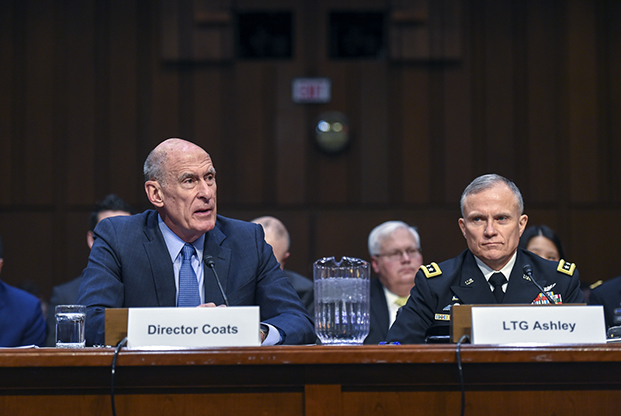
Director of National Intelligence Dan Coats (left) and Defense Intelligence Agency Director Gen. Robert Ashley Jr. appear before the Senate Armed Services Committee on March 6, 2018. DIA photo by Brian Murphy.
A new Trump Administration executive order has rescinded an Obama-era mandate aimed at increasing transparency of US airstrikes and their human toll around the world.
The new order states that the director of national intelligence no longer has to release an annual report on airstrikes “against terrorist targets outside areas of active hostilities,” nor does he need to publish evaluations about how many deaths those strikes cause, including those of civilians, “among other information.” The DNI was first ordered to compile the report in a July 1, 2016 executive order issued by President Barack Obama.
Seth Jones, the Harold Brown chair and Transnational Threats Project director at the Center for Strategic and International Studies, said he wasn’t sure of a geopolitical motivation behind the executive order’s enactment.
“It’s not clear that there’s a cover up, per se, of something that’s going on, but just a desire to keep those kinds of strikes low-profile because they’re sensitive, sensitive intelligence,” Jones said in a March 6 interview with Air Force Magazine. “I mean, the reality, though, is when something blows up, people on the ground know about it that live in the area, so it’s impossible to keep this stuff classified, and it creates opportunities for rumors, … [and] for myths or disinformation if there’s not a bit more transparency from the US.”
However, considering the US track record of conducting airstrikes in Iraq, Afghanistan, Yemen, Libya, and Somalia, and the possibility of it potentially launching future strikes “in the Sahel, or in or around Nigeria with the cooperation of” regional partners, he said, “the US may be prepared to broaden its strikes from the countries it’s currently operating in and doesn’t want to tip its hand.”
Rachel Kleinfeld, a senior fellow in the Carnegie Endowment for International Peace’s Democracy, Conflict, and Governance Program and founding CEO of the Truman National Security Project, said she thinks the executive order will hurt both national security and global efforts to reduce violence and war.
“We’re facing a battlefield in which the number of people arrayed against us can grow,” she told Air Force Magazine in a March 6 interview. Killing people doesn’t shrink that total, and causing civilian casualties is an easy way to fuel anti-American sentiment, she said.
Removing civilian casualty reporting requirements can make it easier for the US government to forget that there’s a correlation between the hearts and minds it’s able to win and the numbers of insurgents the US eventually faces, she said.
“Taking that away makes it much easier to pretend we’re in a war of attrition, which we’re not.” she said.
“We need the reporting requirement, and thus the internal investigation requirement,” said Michael O’Hanlon, a senior fellow at the Brookings Institution. “Decency and our values demand it. The need for operational secrecy in no way precludes it.”
The March 6 executive order seemed to suggest that the DNI-specific reporting rule was made redundant by two similar rules, which its text explained, but didn’t revoke:
- Section 1057 of the 2018 National Defense Authorization Act, which mandates that the defense secretary submit an unclassified, annual “civilian casualty report” to Congressional defense committees (though the inclusion of “a classified annex” is allowed, if needed).
- Section 1062 of the 2019 NDAA, which widened the aforementioned civilian casualty report’s scope and commands that it be publicly available unless the defense secretary says that its publication would threaten US national security.
But Kleinfeld said she doesn’t see the 2018 and 2019 NDAA-linked civilian casualty reporting requirements as redundancies.
“I think the fact that these were passed so recently it is indicative of the fact that Congress recognizes what sorts of wars we’ve been in and the fact that we haven’t been winning them,” she said. “It’s not just that Afghanistan is the longest war our country has ever engaged in. Yemen, which we’re not directly engaged in, of course, but our ally is, and we’re assisting, has been going on for an extraordinarily long time. Iraq is still boiling over in different ways.”
Thus, she said, she viewed Congress’ decision to put additional reporting rules into place so recently reflects a desire on the part of legislators for the US to shift its approach to military engagement.
And,“for the most part,” those legislators should still have the ability to access information on US strikes via briefings or meetings, Jones said.
“I think the broader issue is there’s … an unfortunate public development which is the public’s gonna be a lot more in the dark about … what its own government is doing here,” he said. This lack of transparency is further compounded by the fact that US airstrikes don’t happen on a single “clear battlefield,” so they’re harder for everyday Americans to keep track of.
“This is not just a war in Afghanistan,” he said. “This is much more global than that.”